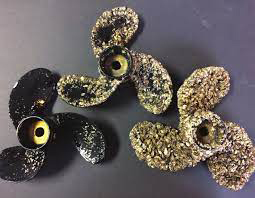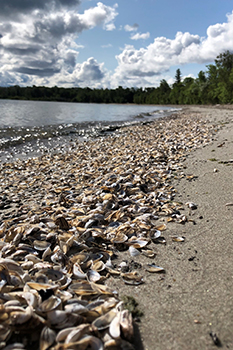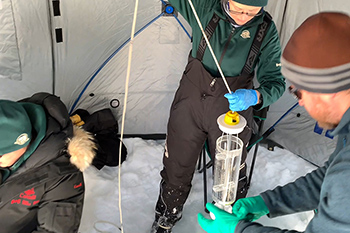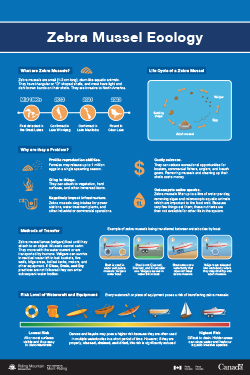
Zebra Mussel Information and Updates
Riding Mountain National Park
May 2024 Update
Effective immediately, and for the time required to determine if a population of zebra mussels has been established in Clear Lake and for any potential remediation during the 2024 open water season only, personal watercraft will not be allowed on Clear Lake. This includes motorized boats and human-powered vessels such as canoes, kayaks, and stand-up paddle boards. This decision is informed by the best available science and Indigenous Knowledge and provides the best opportunity to battle a likely invasion of zebra mussels.
The goal is to confirm whether an established colony of invasive mussels is present in Clear Lake and assess whether eradication is feasible. Personal watercraft complicate detection efforts, increase the risk of spread within the lake and to other waterbodies, interfere with water sampling, and prolong the search.
Parks Canada will continue to work with members of the Keeseekoowenin Ojibway First Nation, Clear Lake Marina, the Province of Manitoba’s Aquatic Invasive Species Unit, and Fisheries and Oceans Canada to conduct zebra mussel monitoring efforts over the coming months.
Timeline
- Summer 2011 – Monitoring for zebra mussels in Clear Lake begins.
- Summer 2015 – Mandatory Parks Canada AIS inspections and decontaminations begin at Riding Mountain National Park.
- Summer 2011 to 2023 – Water samples from Clear Lake and surrounding water bodies are taken and tested for zebra mussel eDNA.
- January 2023 – Parks Canada is informed by Fisheries and Oceans Canada of a positive test result for zebra mussel eDNA in a water sample taken at an area known as Boat Cove, in Clear Lake on August 4, 2022.
- February 2023 – Parks Canada implements an unprecedented winter zebra mussel eDNA monitoring program in the area to search for further evidence. No more samples tested positive.
- May 4, 2023 – Parks Canada announced that trailered watercraft intended for use on Clear Lake must not have been in any other waterbody in 2023 and must undergo an inspection by June 15. Boats that met the requirements had a tag installed that sealed the boat to the trailer. This tag ensured that the watercraft had not been in another waterbody and posed no risk of bringing in aquatic invasive species. If this tag was removed or tampered with, the boat would not be allowed to launch in Clear Lake for the remainder of the 2023 season. All human-propelled vessels (canoes, kayaks, stand-up paddle boards) were required to undergo a Parks Canada AIS inspection, and if needed, decontamination before launching in park waters.
- November 2023 – Parks Canada is informed by Fisheries and Oceans Canada of multiple water sample tests indicating positive results for zebra mussel eDNA throughout the summer near Boat Cove, in Clear Lake.
- November 10, 2023 – Parks Canada officials do a physical search Boat Cove and a clump of 48 live zebra mussels was found and removed from the water. Before that, zebra mussels had never been found in Riding Mountain National Park. The discovery was subsequently communicated to the public.
- December 2023 – Parks Canada holds open house public forums in Onanole and Brandon to discuss the situation, provide information, and gather input. An online session was held in January 2024.
- January 2024 – Parks Canada began collecting water samples from various locations throughout Clear Lake to locate zebra mussels at any life stage with members of Keeseekoowenin Ojibway First Nation, the Province of Manitoba’s Aquatic Invasive Species Unit, and Fisheries and Oceans Canada. On-ice water sampling was prioritized based on areas where the mussels are most likely to colonize first, such as access points like boat launches and recreational beaches.
The map below shows Clear Lake broken down into 219 sections. Water samples were taken from sections based on priority.

- February 2024 – The first set of water samples collected from Clear Lake between January 8 and February 2, 2024, tested negative for zebra mussel environmental DNA (eDNA).
- March 2024 –The second set of water samples collected from Clear Lake between February 2 and February 20, 2024, tested negative for zebra mussel environmental DNA (eDNA). All high-priority sections have been tested.
- April 2024 – On-ice water sampling for zebra mussel environmental DNA (eDNA) from Clear Lake ended on April 5, 2024, due to melting ice conditions. All test results from water samples taken throughout the winter of 2024 have been negative. Zebra mussels may be present despite negative eDNA results. In cold water, zebra mussels are less metabolically active and are much less likely to shed eDNA.
Zebra mussels
Zebra mussels (Dreissena polymorpha) are native to eastern Europe. They were first detected in North America in the Great Lakes in the mid-1980s. Since then, they have infested many waterbodies in eastern North America. They were first detected in Manitoba in 2013 when they were discovered in the south basin of Lake Winnipeg. They later also colonized the Red River from the US border to Lake Winnipeg. Since then, they have invaded the Nelson River from Lake Winnipeg to Hudson Bay, as well as Cedar Lake and Lake Manitoba.
Biology
Zebra mussels are freshwater hinged mollusks. They are filter feeders that attach themselves to solid surfaces. They breed very quickly, as females can release up to one million eggs each breeding season. After the eggs are fertilized, larvae (called veligers) emerge and are free-floating for up to a month. The larvae are microscopic and do not swim. Veligers float through lake and river currents until they settle on a solid surface. This natural dispersal method means they can easily affect waterways downstream from an invaded area. Zebra mussels have few, if any, natural predators in North America. As a result, they often permanently alter the food web and ecosystems they invade.
Negative impacts on people include:

- Increased maintenance costs
- Damage to equipment such as boats, hydro-electric generating facilities, water intakes, and other infrastructure along infested water bodies
- Injury from sharp shells
- Potential negative health impacts resulting from increased likelihood of toxic algae blooms
- Beach closures
Negative impacts on aquatic ecosystems:

- Altering the food web by out-competing native species, like native mussels and other small invertebrates, for food (plankton)
- Removing large amounts of non-toxic algae (plankton) from the water and leaving behind toxic algae (cyanobacteria) to thrive, causing toxic algae blooms
- Affecting fish spawning areas by changing the surfaces of rocks and vegetation, impacting the survival of fish eggs
- Creating clearer water, allowing sunlight to penetrate deeper and changing the habitat by increasing the growth of submerged aquatic vegetation
Zebra mussels are especially harmful to native mussels, many of which are species at risk. They outcompete these species for food and will attach themselves to native mussels, suffocating them.
An infestation of zebra mussels in Clear Lake presents a real threat of significant and irreversible damage to the lake and downstream waterbodies.
Discovery of zebra mussels in Clear Lake
Positive eDNA Samples

The results of testing completed in the summer of 2023, indicated the presence of environmental DNA (eDNA) for zebra mussels throughout the season, prompting the physical search at the Boat Cove. In November 2023, a clump of living mussels was removed from Clear Lake in Riding Mountain National Park. The search for further evidence of their presence somewhere else in Clear Lake began.
Winter Monitoring and Sampling
Over the winter, water samples were collected from Clear Lake and tested for zebra mussel environmental DNA (eDNA) at the Freshwater Institute operated by Fisheries and Oceans Canada in Winnipeg. In cold water, zebra mussels are less metabolically active and are much less likely to shed eDNA; therefore, zebra mussels may be present despite the negative eDNA results from this winter. Positive eDNA samples can give a better idea of where a population might be located. Sampling continued until the ice was no longer safe and will resume on open water as soon as possible.
Clear Lake
Clear Lake is a unique lake for the prairie parkland area. It is oligotrophic, meaning it has low amounts of nutrients in the lake, giving it a clear look and making it a suitable source of clean, fresh drinking water. Clear Lake is a key habitat for 14 fish species, including whitefish, northern pike, white sucker, walleye, and slimy sculpin. Whitefish are the most abundant large-bodied fish in Clear Lake and are usually found in the deeper parts of the lake along with slimy sculpin. Both species are considered ecological indicators of the health of the lake as they require a well-oxygenated lake bottom to survive.
Working Together
Parks Canada staff at Riding Mountain National Park are working with AIS specialists from other Parks Canada administered sites, Members of Keeseekoowenin Ojibway First Nation, the Province of Manitoba’s AIS Unit, and Fisheries and Oceans Canada. The Keeseekoowenin Ojibway First Nation (KOFN) maintains authority and control of fishing station IR 61A on the northwest shores of Clear Lake.
The likelihood of success for any potential eradication action will depend on whether an intervention can happen before significant reproduction and spreading occurs within the lake. Determining with relatively high confidence where they exist in the lake would help to inform potential eradication options.
Terms to Know
Ecological Integrity: An ecosystem has ecological integrity when:
- It has the living and non-living components expected in its natural region.
- It's processes (the engines that make an ecosystem work, e.g. fire, flooding, predation) occur with the frequency and intensity expected in its natural region.
Ecological integrity is an important priority in all aspects of managing a national park. Parks Canada runs an ecological integrity monitoring program across all parks. This involves taking an inventory of what is found at each park and monitoring how it is doing. Monitoring and reporting on the ecological integrity of parks allows Parks Canada, in collaboration with partners, to make informed decisions about protected areas, and to inform Canadians and other audiences.
eDNA: DNA is the genetic material found in humans and most other living things. DNA can be released by organisms into the environment from sources such as feces, mucus, skin cells, hair, etc. This is known as environmental DNA (eDNA). Scientists can collect samples from the environment to see what DNA is there. Riding Mountain National Park does this with water samples collected from lakes to test for DNA from zebra mussels.
Questions and Answers
Clear Lake
Are there any boats allowed on Clear Lake this year?
- The commercial tour boat (Martese) operated by the Clear Lake Marina. This will enable visitors to still have an experience on Clear Lake at minimal risk. This watercraft will be used for zebra mussel veliger (larvae) monitoring and education.
- A boat owned by Keeseekoowenin Ojibway First Nation, for cultural use and participation in the zebra mussel monitoring program.
- Boats used by Parks Canada for zebra mussel monitoring and emergencies.
These watercraft will be inspected for AIS weekly.
Is this change being implemented permanently?
The watercraft management measures are temporarily in effect for the 2024 season, to ensure that accurate sampling and monitoring can take place.
Parks Canada will provide an opportunity for the public to share their input on AIS prevention measures for 2025, based on the results of sampling and monitoring efforts undertaken this season.
Can visitors still swim and fish in Clear Lake?
Swimming is allowed, as will the use of beach toys, inflatables, and personal floatation devices. Angling will continue to be permitted in Riding Mountain National Park as per regulations. Angling for all fish in Clear Lake must be done from the shore. For more information about angling in RMNP visit: Fishing
Protecting our water bodies is a shared responsibility. Everyone has an important role to play. When accessing any authorized waterbody, follow the Clean, Drain, Dry protocol and have your equipment inspected and decontaminated as necessary.
2024 AIS prevention for other waterbodies
Can I launch my boat in other lakes in the park?
Non-motorized/self-propelled watercraft are permitted to enter park waters other than Clear Lake, after receiving a Parks Canada AIS inspection permit at the Boat Cove in Wasagaming, and a decontamination if necessary. Temporary permits will still be available for the 2024 season and can be issued for up to seven days.
Seasonal permits will be available for watercraft using outlying lakes such as Moon Lake, Lake Audy, and Lake Katherine. For more information about the 2024 AIS prevention program visit: Aquatic Invasive Species Prevention Program
When you use your watercraft and/or water-related equipment outside of RMNP, your permit becomes invalid. To re-enter park waters, re-inspection is mandatory. Park Wardens will be monitoring watercraft and doing checks to ensure that watercraft operators have received inspections and possess valid permits. Non-compliant operators face a maximum fine of $25,000.
Protecting our water bodies is a shared responsibility. Everyone has an important role to play. When accessing any authorized waterbody, follow the Clean, Drain, Dry protocol and have your equipment inspected and decontaminated as necessary.
Where will visitors be able to have their self-propelled watercraft inspected?
The AIS inspection station at Boat Cove in Wasagaming will be regularly staffed in 2024. Staff may also be stationed at busy sites throughout the season to provide inspections. More information about the AIS prevention program for 2024 can be found online here: Aquatic Invasive Species Prevention Program

Is there a penalty for launching prohibited watercraft in Riding Mountain National Park?
Under the Canada National Parks Act the maximum penalty for launching a prohibited watercraft in the park is $25,000. The offender can be arrested, their watercraft seized, and the offender will be compelled to attend court. If found guilty, in addition to the fine imposed by the court, the crown can seek forfeiture of the seized watercraft.
Monitoring and Testing
What sampling and monitoring efforts will be undertaken this summer?
The sampling design for zebra mussel monitoring on Clear Lake is currently in progress with input from scientists with expertise in AIS and eDNA study design.
Monitoring will include visual surveys with the use of dive teams and a remotely operated vehicle (ROV), eDNA sampling techniques, plankton tows (veliger detection), and substrates used to find growing mussels, to maximize the detectability during the 2024 open water season.
Monitoring will be concentrated in high-priority areas within the lake and will take place as soon as it is safe to do so when Clear Lake becomes ice-free. This typically occurs in the last few weeks of May.
Parks Canada will be working closely with Fisheries and Oceans Canada, the Manitoba AIS unit, and Keeseekoowenin Ojibway First Nation to carry out zebra mussel monitoring activities on Clear Lake in 2024.
Zebra mussels
Do zebra mussels help by cleaning dirty water?
Zebra mussels can filtre 1 litre of water per day, consuming plankton, and small organisms that native species rely on. Zebra mussels can have significant negative impacts on freshwater habitats by out-competing native species for food. When found in high densities, the mussels can have strong impacts on algae, which are the base of the food web. The plankton is filtered and ingested, but toxic algae is not consumed, allowing it to accumulate to dangerous levels.
How do zebra mussels damage infrastructure?

Parks Canada is responsible for protecting the lakes, rivers, and streams in Riding Mountain National Park. In addition to significant ecological effects, invasive mussels are known to cause extensive economic and visitor experience impacts by clogging water intake structures, dams, water treatment facilities, hydropower facilities, docks, breakwaters, buoys, boats, and beaches.
Clear Lake is at the headwaters of the Little Saskatchewan River, which drains into the Assiniboine River. The downstream risk of zebra mussel contamination in Manitoba threatens the extensive irrigation network that supports southern Manitoba’s significant agricultural industry; infrastructure that supports water supply for multiple jurisdictions, including the cities of Minnedosa and Brandon; and the ecological health for multiple recreational areas.
What’s the point of limiting watercraft on the lake? Won't migrating waterfowl spread AIS anyway?
No. The “gizzard” or digestive tract of birds destroys zebra mussels, therefore there is no risk of spreading zebra mussels through bird droppings. Wildlife living near waterbodies, such as waterfowl, do not stay still long enough for a zebra mussel veliger to secure itself.
Parks Canada is acting now, to manage things that are within our control, to ensure that the ecological integrity of the park’s aquatic communities, and those of downstream waterbodies remains intact.
Can zebra mussels swim?
Mussels cannot swim freely at any point in their lifecycle. During the larval phase, the zebra mussel larva (veliger) free-float in the water until it attaches to an object. That larvae will develop a shell and tendrils that secure the mussel in place. Clams, on the other hand, can swim using a foot-like appendage.
For more information contact: comms-riding@pc.gc.ca
Information:
- Date modified :



 579 KB
579 KB

